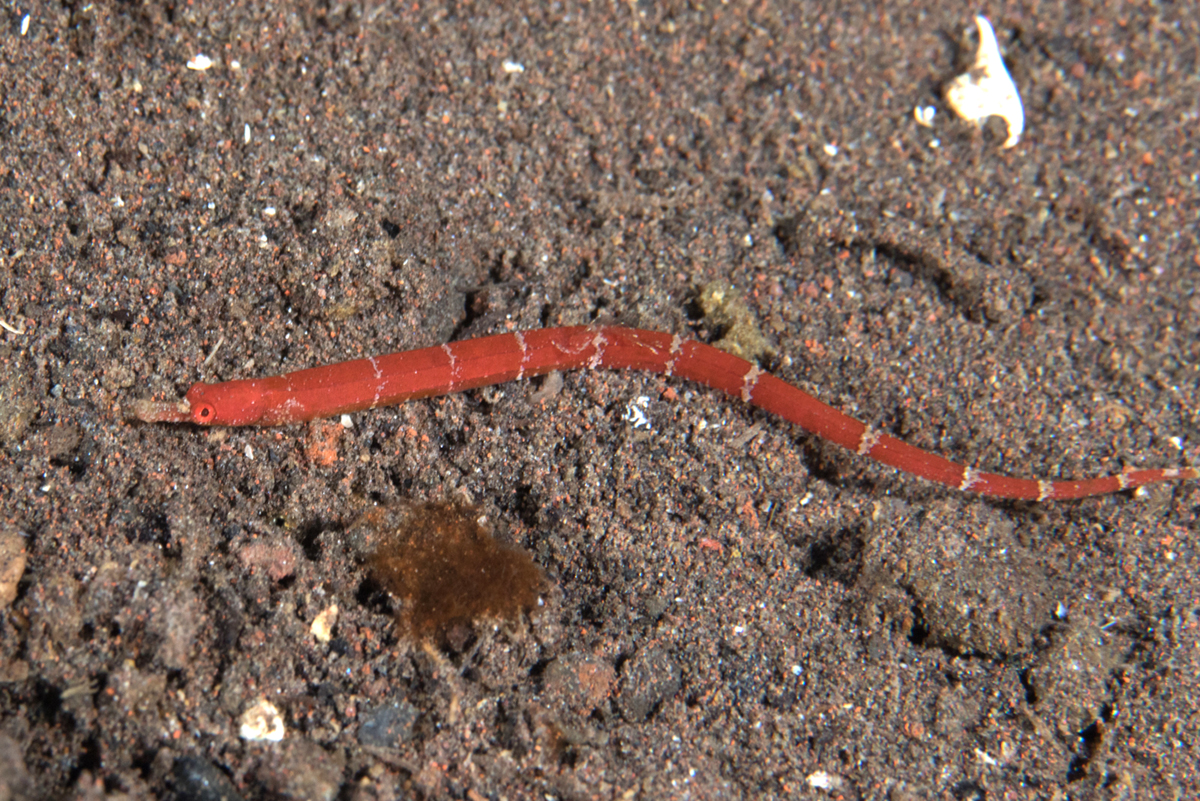Maxweber's Pipefish, Cosmocampus maxweberi (Whitley 1933)

Maxweber's Pipefish, Cosmocampus maxweberi, at Karang Asem, Bali, Indonesia, August 2015. Source: Mark Rosenstein / iNaturalist. License: CC by Attribution-NonCommercial-ShareAlike
This secretive tropical species often hides under coral rubble on shallow inner reefs.
Maxweber's Pipefish, Cosmocampus maxweberi (Whitley 1933)
More Info
|
Distribution |
Tropical Indo-west-central Pacific, Red Sea, Indonesia, Great Barrier Reef, to Micronesia, Tonga and Samoa; inhabits inshore reefs among rubble to 35 m, although more common on shallow reefs to 4 m. |
|
Features |
Meristics: D 23-27; P 16-18;Trunk rings 14-15; Tail rings 29-32. Head and body: Head length 5.3-6.8 in SL, snout length 1.6-1.9 in HL. Superior trunk and tail ridges discontinuous; lateral trunk ridge straight, ends near anal ring; median dorsal snout ridge entire; principle body ridges not strongly elevated; usually with minute dermal flaps on eye; distal third or more of tail with posterior angles of rings produced to points. |
|
Size |
Reaches about 100 mm TL. |
|
Colour |
Pale red to tan with a dark lateral stripe on the snout and brown dorsally on head; lower half of side and ventral surface of trunk usually with dark brown bars. |
|
Feeding |
Unknown, but likely to feed on small crustaceans. |
|
Biology |
Reproduction: Ovoviviparous (gives birth to live young). The eggs are brooded by the males in a pouch on the underside of the body. The pouch protects the dorsal surface and side of the egg mass, leaving the ventral surface exposed. Males may begin brooding at 62 mm TL. Eggs: Eggs are deposited in 2-17 transverse rows within a gelatinous matrix. Larvae: Planktonic larvae, morphologically similar to adults. Planktonic juveniles (24-29 mm SL) have been taken in the upper 85 m over depths of 1565-2010 m. |
|
Fisheries |
Of no interest ot fisheries or aquaculture. |
|
Conservation |
Australian Government Legislation: Marine listed under the Environment Protection and Biodiversity Conservation Act 1999. State Government Legislation: Listed as protected under the New South Wales Fisheries Management Act. |
|
Remarks |
C. maxweberi is often found under large pieces of coralline rubble at depths of less than 4 m. |
|
Etymology |
Cosmocampus is from the Greek, kosmos meaning order or organisation, and the Greek, kampe for sa animal. The specific name maxweberi is for the Dutch explorer Max Wilhelm Carl Weber, who initially descibed the species as Syngnathus punctatus. |
|
Species Citation |
Syngnathus (Parasyngnathus) maxweberi Whitley 1933, Rec. Aust. Mus. 19(1): 66, Saleh Bay, Sumbawa Island, Lesser Sunda Islands, Indonesia. |
|
Author |
Thompson, Vanessa J. & Dianne J. Bray |
Maxweber's Pipefish, Cosmocampus maxweberi (Whitley 1933)
References
Allen, G.R. & M. Adrim. 2003. Coral reef fishes of Indonesia. Zool. Stud. 42(1): 1-72.
Dawson, C.E. 1985. Indo-Pacific Pipefishes (Red Sea to the Americas). Gulf Coast Research Laboratory, Ocean Springs, Mississippi. 230 pp.
Dawson, C.E. 1980. Notes on some Siboga Expedition pipefishes previously referred to the genus Syngnathus. Bijdragen tot de Dierkunde 50(1): 221-226.
Hoese, D.F., D.J. Bray, J.R. Paxton & G.R. Allen. 2006. Fishes. In Beesley PL & Wells A (eds) Zoological catalogue of Australia. Volume 35 ABRS & CSIRO Publishing: Australia. 2178 pp.
Kuiter, R.H. 2000. Seahorses, Pipefishes and their Relatives. Chorleywood, UK: TMC Publishing. 240 pp.
Kuiter, R.H. & T. Tonozuka. 2001. Pictorial guide to Indonesian reef fishes. Part 1. Eels- Snappers, Muraenidae - Lutjanidae. Zoonetics, Australia. 302 pp.
Myers, R.F. 1999. Micronesian reef fishes. A comprehensive guide to the coral reef fishes of Micronesia. 3rd revised ed. Coral Graphics, Guam. 330 pp, 192 pls.
Pogonoski, J.J., D.A. Pollard & J.R. Paxton. 2002. Conservation Overview and Action Plan for Australian Threatened and Potentially Threatened Marine and Estuarine Fishes. Environment Australia, Canberra. 375 pp.
Randall J.E. 2005. Reef and shore fishes of the south Pacific. University of Hawai‘i Press, Honolulu. 707 pp.
Weber M. 1913. Die Fische der Siboga-Expedition. Sber. K. Akad. Wien (Math. Nat. Kl.) 57: 1-710.
Whitley G.P. 1933. Studies in Ichthyology No. 7. Rec. Aust. Mus. 19(1): 60-112.


